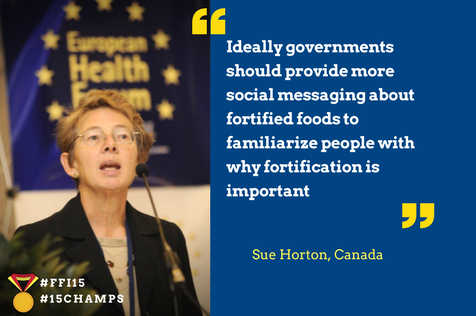Professor, and CIGI Chair in Global Health Economics, University of Waterloo in Canada

FFI: What inspired you to become involved with food fortification?
Horton: The then-Micronutrient Initiative (now Nutrition International) commissioned Jay Ross and me to write a technical paper on economics of iron. This was a challenging project because the biology of iron is complicated, so it took a while for an economist to understand. But it became clear to me that iron fortification was more feasible and successful than iron supplementation for most of the population – although supplementation is also necessary for women of reproductive age and especially pregnant women.
FFI: How is your country prioritizing fortification?
Horton: Canada has been a leader. It was one of the early countries to add folic acid to its fortification programs. Canadians have been leaders in supporting fortification globally: it was a Canadian (Sonia Rabeneck) who encouraged the World Food Programme to fortify cooking oil with vitamin A in food aid shipments; Stan Zlotkin is well-known for his work on multiple micronutrient powders, Quentin Johnson is a well-known technical expert on fortification, and Zulfi Bhutta’s group on Global Child Health has also worked on wheat flour fortification.
FFI: What other projects are you currently working on?
Horton: We have just completed a three-year project which aimed to assist small and medium enterprises in two regions of Tanzania to fortify unrefined sunflower oil with vitamin A. My partners were Mennonite Economic Development Associates of Waterloo, and Sokoine University of Agriculture in Morogoro, Tanzania. Since East Africa has high rates of vitamin A deficiency, it was a great opportunity not only to improve nutrition but also help create local employment, reach households who are not typically targeted by large-scale fortification, and generate beneficial environmental impact.
FFI: What health outcomes do you expect fortification to improve in your country?
Horton: Vitamin D fortification of milk is essential because we live in a country where – especially in winter – people don’t get enough sunlight. Even in summer, Canadians who practice veiling and don’t expose their skin are at risk of deficiency. But there will be new challenges going forward – those consuming gluten-free diets may not receive fortification with iron and folic acid; those consuming milk substitutes may not receive enough vitamin D, etc.
FFI: What are the greatest challenges you have encountered in planning or implementing fortification programs? And how did you address those challenges?
Horton: We are writing articles about the Tanzania project right now. It is difficult to assist small and medium enterprises to compete effectively with large enterprises. It is difficult for governments to enforce legislation for small and medium millers, so the playing field is not level. It is difficult for small producers to navigate the regulatory bureaucracy required to get authorization for fortification. Ideally the government should be providing more social messaging about fortified foods to familiarize people with the concept and why fortification is important. We hope to submit our research findings soon!

